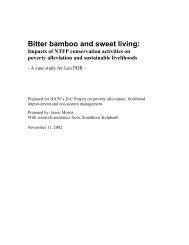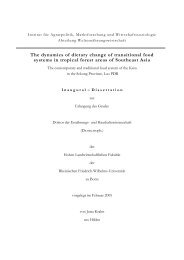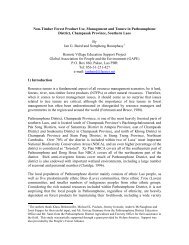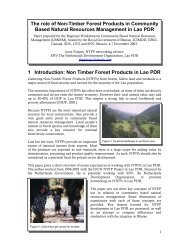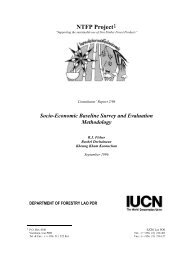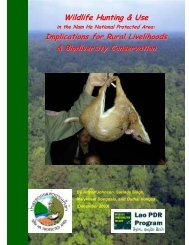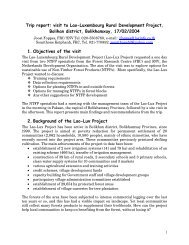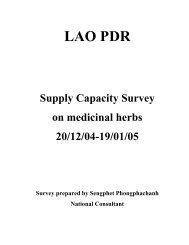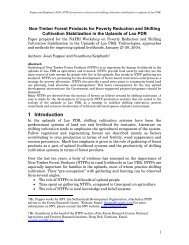Create successful ePaper yourself
Turn your PDF publications into a flip-book with our unique Google optimized e-Paper software.
6 Potential use of NTFP’s in the proposed resettlement area<br />
In this chapter we try to asses the relative sustainability of present harvesting of NTFP’s by<br />
looking at three main characteristics of the main species. Firstly, we gauge the effect of<br />
harvesting <strong>on</strong> the regenerati<strong>on</strong>/survival of the species (ecological sustainability). Sec<strong>on</strong>dly<br />
we look at the trends in prices and quantities collected (ec<strong>on</strong>omical or market sustainability).<br />
Thirdly, we look at the potential for domesticating the species, especially <strong>on</strong> the sandy soils<br />
of the proposed resettlement area.<br />
kisi: the damar resin exudes naturally from the tree, falls off the tree and is collected from the<br />
forest floor. This type of harvesting does not harm the producing tree and is very sustainable,<br />
provided trees are not cut down. The main threat to kisi producti<strong>on</strong> is logging of trees of mai<br />
si, which has a good quality wood. Many trees are taken out of the reservoir area right now.<br />
Logging of these trees above the future water level should be avoided.<br />
The current price of kisi is 150 kip/kg, which is rather low. The demand for kisi resin seems<br />
stable, the price has not changed much over the past three years. An average full grown tree<br />
(height over 40 m.) produces 3-5 kg per year. It is not difficult to plant “si” trees, but<br />
villagers will not likely be motivated to do so as it take 50-100 years for a tree to mature and<br />
the trees do not have individual ownership.<br />
b<strong>on</strong>g bark: Producti<strong>on</strong> has g<strong>on</strong>e down sharply over the last year, because villagers have cut<br />
all the harvestable trees already. Normally trees regrow from coppice after harvesting, but<br />
high harvesting pressure may have killed quite a lot of stumps. This tree is easy to plant and<br />
can be harvested after 3-4 years. So we can say that although present harvesting is not<br />
sustainable, the prospects for sustainable harvesting are good. The prices are rather low: 60-<br />
100 kip/kg. An average tree produces 0.5 to 1 kg of bark. The b<strong>on</strong>g bark is exported as raw<br />
material for making incense, mainly joss sticks. There is a good potential for introducing joss<br />
stick manufacturing to the villages, combined with a plantati<strong>on</strong> effort.<br />
cardamom: Cardamom is harvested by picking the fruits from the plants. If the fruits are cut<br />
carefully with a knife instead of pulling most of the plant from the soil, harvesting is<br />
sustainable. The main problem now is the low densities in natural stands. This plant is easy to<br />
grow under the right c<strong>on</strong>diti<strong>on</strong>s: good deep soils, under trees, abundant rainfall. The price for<br />
raw cardamom <strong>on</strong> the <strong>Nakai</strong> plateau is now 3,000 kip/kg. The price of cardamom has risen<br />
very spectacularly over the last three years in Laos. In Champasak Province, cardamom went<br />
up from 1,200 in 1994 to 8,000 kip in 1997. It is now the sec<strong>on</strong>d most important export<br />
product there, after coffee. In Champasak and Salavane Province, many farmers have planted<br />
cardamom in forest gardens, which produce about 300 kg/ha/year. In <strong>on</strong>e village where we<br />
did a survey in October last year, <strong>on</strong> average each of the 200 households had an income from<br />
cardamom of more than 1,000,000 kip.<br />
On the <strong>Nakai</strong> plateau, many of the present stands of cardamom are found at low elevati<strong>on</strong>s in<br />
or near the future inundati<strong>on</strong> z<strong>on</strong>e, and may disappear after flooding. However the potential<br />
for cultivati<strong>on</strong> should be studied as the market prospects are so good. The main problem to be<br />
overcome will be to find sufficient water to provide the crop with an all year moist soil. This<br />
may prove to be difficult <strong>on</strong> the traditi<strong>on</strong>ally dry, sandy soils of the proposed resettlement<br />
area.



